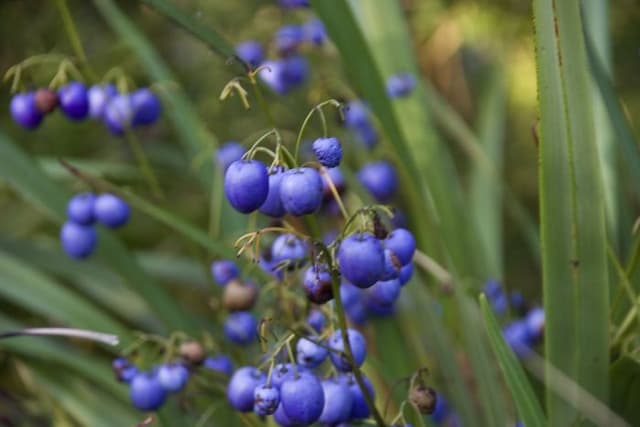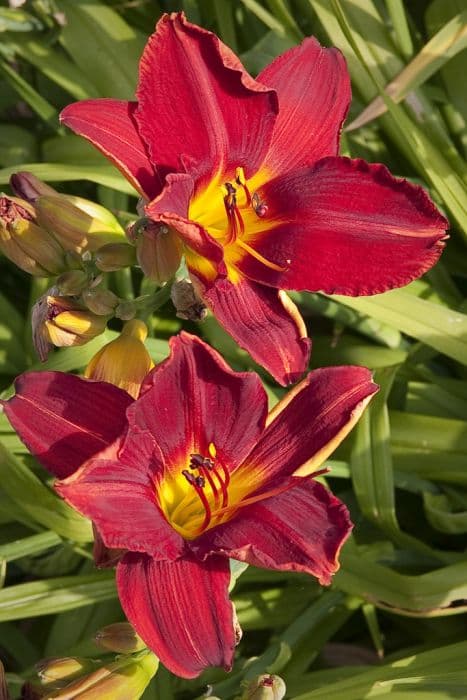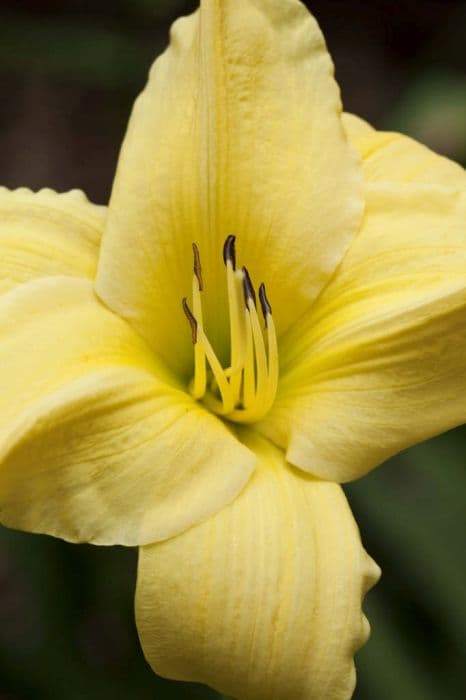New Zealand Flax Phormium tenax Purpureum Group

ABOUT
The plant known as New Zealand flax 'Purpureum' is recognized for its striking appearance. This ornamental variety features sword-shaped leaves that are a deep purple-reddish hue, boasting a rich and dramatic coloration that stands out in garden settings. The leaves are long and arching, emerging from the base of the plant in a fan-like display that gives it a distinct and lush look. The texture of the leaves is leathery with a slightly shiny or waxy finish, which helps to accentuate their color. Over time, this plant develops into a clump-forming perennial, creating a dense and bushy presence. New Zealand flax 'Purpureum' can add an exotic touch to a variety of landscape designs, offering a bold foliage contrast against lighter-colored plants.
About this plant
 Names
NamesFamily
Asphodelaceae.
Synonyms
New Zealand Flax, Purple New Zealand Flax, Purple Flax.
Common names
Phormium tenax Purpureum Group.
 Toxicity
ToxicityTo humans
New Zealand flax is not known to be highly toxic to humans. However, ingestion of its leaves may cause mild stomach upset. If large quantities are consumed, there could be more severe gastrointestinal distress. As with any plant, individual allergies can occur, so it's always best to be cautious and avoid ingesting plants not known to be safe for consumption.
To pets
New Zealand flax is considered to be of low toxicity to pets. If a pet ingests this plant, they might experience mild gastrointestinal symptoms, such as vomiting or diarrhea. Typically, serious poisoning is not expected, but it's always wise to monitor your pet and consult with a veterinarian if any concerning symptoms arise after ingestion of any plant material.
 Characteristics
CharacteristicsLife cycle
Perennials
Foliage type
Evergreen
Color of leaves
Mixed
Height
7 feet (2.1 meters)
Spread
6 feet (1.8 meters)
Plant type
Shrub
Hardiness zones
8
Native area
New Zealand
Benefits
 General Benefits
General Benefits- Ornamental Appeal: Adds striking color and dramatic texture to gardens with its deep purple foliage.
- Drought Tolerance: Once established, it has low water requirements, making it suitable for dry or xeriscape gardens.
- Wind Resistance: Its robust nature allows it to withstand windy conditions, ideal for coastal landscapes.
- Low Maintenance: Requires minimal care once established, needing little more than occasional tidying up.
- Soil Versatility: Adapts well to different soil types, although it prefers well-draining conditions.
- Wildlife Support: The flowers are attractive to birds and insects, providing nectar and habitat.
- Architectural Plant: The strong vertical lines and form provide architectural interest to garden designs.
- Erosion Control: Its root system helps stabilize slopes and banks, preventing soil erosion.
- Cultural Significance: An important plant in Maori culture, used traditionally for weaving and other purposes.
- Garden Variability: Available in a range of cultivars offering various sizes and shades of color for garden themes.
 Medical Properties
Medical PropertiesThis plant is not used for medical purposes.
 Air-purifying Qualities
Air-purifying QualitiesThis plant is not specifically known for air purifying qualities.
 Other Uses
Other Uses- Phormium tenax Purpureum Group, commonly known as New Zealand Flax, fibers were traditionally used by the Māori to create fishing lines and nets due to their strength and durability.
- The leaves of New Zealand Flax are sometimes used in thatching and for making robust outdoor mats, showcasing their versatility beyond ornamental gardening.
- Waterproof baskets and containers can be woven from the leaves of the New Zealand Flax, as the fibers are resistant to rotting when damp.
- New Zealand Flax leaves are also employed in the craft of hat-making, where they are dried, dyed, and woven into stylish and hard-wearing headwear.
- The flower stalks of New Zealand Flax, which can grow quite tall, are used to create natural supports or stakes in the garden for other plants.
- The plant has been used in the past to make a natural dye that yields a rich, authentic rust-brown color that has been used in textile coloring.
- During emergencies, New Zealand Flax leaves can be used as a form of impromptu twine or rope due to their length and strength.
- New Zealand Flax is sometimes incorporated into animal habitats and aviaries as a form of natural shelter and nesting material for birds.
- Artisans and crafters use dried New Zealand Flax leaves to create unique, eco-friendly pieces of art and sculpture.
- In landscaping, the contrasting purplish foliage of the Purpureum Group can be used to create dramatic backdrops and add structural interest to garden designs.
Interesting Facts
 Feng Shui
Feng ShuiThe New Zealand Flax is not used in Feng Shui practice.
 Zodiac Sign Compitability
Zodiac Sign CompitabilityThe New Zealand Flax is not used in astrology practice.
 Plant Symbolism
Plant Symbolism- Strength and Resilience: Known as New Zealand Flax, Phormium tenax Purpureum Group's fibrous leaves have traditionally been used in weaving by the Māori people, symbolizing strength and the ability to withstand harsh conditions.
- Adaptability: The ability of New Zealand Flax to adapt and thrive in various soil types and weather conditions represents adaptability and versatility.
- Versatility: Historically used for diverse purposes from clothing to fishing lines, New Zealand Flax symbolizes resourcefulness and utility.
 Water
WaterNew Zealand Flax prefers consistent moisture and should be watered deeply when the top inch of soil feels dry, typically once a week. Adjust frequency depending on weather conditions; in hot, dry periods, water may be needed more frequently, such as twice a week, whereas in cooler, wetter periods, less frequent watering is required. It's important to avoid overwatering, so ensure the plant has well-draining soil. For potted plants, watering until water runs through the drainage holes is a good practice. Depending on the size of the plant and environmental conditions, a mature New Zealand Flax may require 1-2 gallons per watering session.
 Light
LightNew Zealand Flax thrives best in full sun to partial shade. It prefers a sunny spot that receives at least six hours of direct sunlight per day. However, in hotter climates, some afternoon shade can help protect the plant from intense, potentially damaging heat.
 Temperature
TemperatureNew Zealand Flax is hardy and tolerates a wide range of temperatures, but it performs best in temperatures between 50°F and 75°F. It can withstand temperatures as low as 20°F for short periods but may suffer damage in prolonged cold. Conversely, it can endure high temperatures well into the 90s°F, particularly if it's well-watered and has some protection from the hottest sun.
 Pruning
PruningNew Zealand Flax should be pruned to remove damaged or old leaves and to maintain its shape. The best time to prune is in late winter or early spring before new growth starts. It's typically sufficient to prune once per year, but if the plant is damaged or grows excessively, an additional pruning might be necessary. Cutting back to the base of any brown or damaged leaves will help keep the plant looking tidy and encourage fresh, healthy growth.
 Cleaning
CleaningAs needed
 Soil
SoilNew Zealand Flax prefers well-draining soil with a slightly acidic to neutral pH, ranging from 5.5 to 7.0. The best soil mix can be made by combining two parts peat moss or coco coir, one part perlite or coarse sand, and one part garden soil or compost. This creates a loose, fertile mix that retains moisture while still allowing excess water to drain away, preventing root rot.
 Repotting
RepottingNew Zealand Flax, being a large and robust plant, does not need frequent repotting. It should be repotted every 2 to 3 years, or when it becomes pot-bound. Repotting in spring allows the plant to recover and grow into its new container during the growing season.
 Humidity & Misting
Humidity & MistingNew Zealand Flax is quite tolerant of various humidity conditions and does well in the average humidity found in most homes. There is no need for specific humidity adjustments for this plant, making it adaptable to both indoor and outdoor environments.
 Suitable locations
Suitable locationsIndoor
Place New Zealand Flax in bright, indirect light indoors.
Outdoor
Plant New Zealand Flax in full sun to part shade outdoor.
Hardiness zone
8-11 USDA
 Life cycle
Life cyclePhormium tenax Purpureum Group, commonly known as New Zealand flax or Purple New Zealand flax, begins its life cycle as a seed that germinates in warm, moist soil. Upon germination, a seedling emerges and grows into a clump-forming perennial with long, sword-shaped, purple or bronze leaves. As the plant matures, it develops a strong root system and the foliage becomes more robust. The mature plant eventually sends up flower spikes in the summer, which are attractive to birds and insects, bearing tubular flowers that can range in color from yellow to red. After pollination, the flowers give way to seed capsules that dry and split open to release seeds, completing the reproductive cycle. As the plant ages, older leaves may die back and need to be removed to maintain its appearance and encourage new growth, marking the continuation of the growth cycle.
 Propogation
PropogationPropogation time
Spring-Early Summer
Propogation: The most popular method for propagating New Zealand Flax, or Phormium tenax 'Purpureum Group', is by division in spring. To propagate by division, carefully dig up the plant and use a sharp knife or spade to slice through the thick, fleshy roots, ensuring that each section has at least one growing point or fan of leaves. These divisions should then be replanted at the same depth they were growing originally and watered thoroughly. Re-establishment is typically rapid, and the divisions will often start to grow new shoots within a few weeks, given appropriate care and favorable conditions. This method not only helps to rejuvenate older clumps that might be losing vigor, but also allows gardeners to create many new plants relatively easily and quickly.









